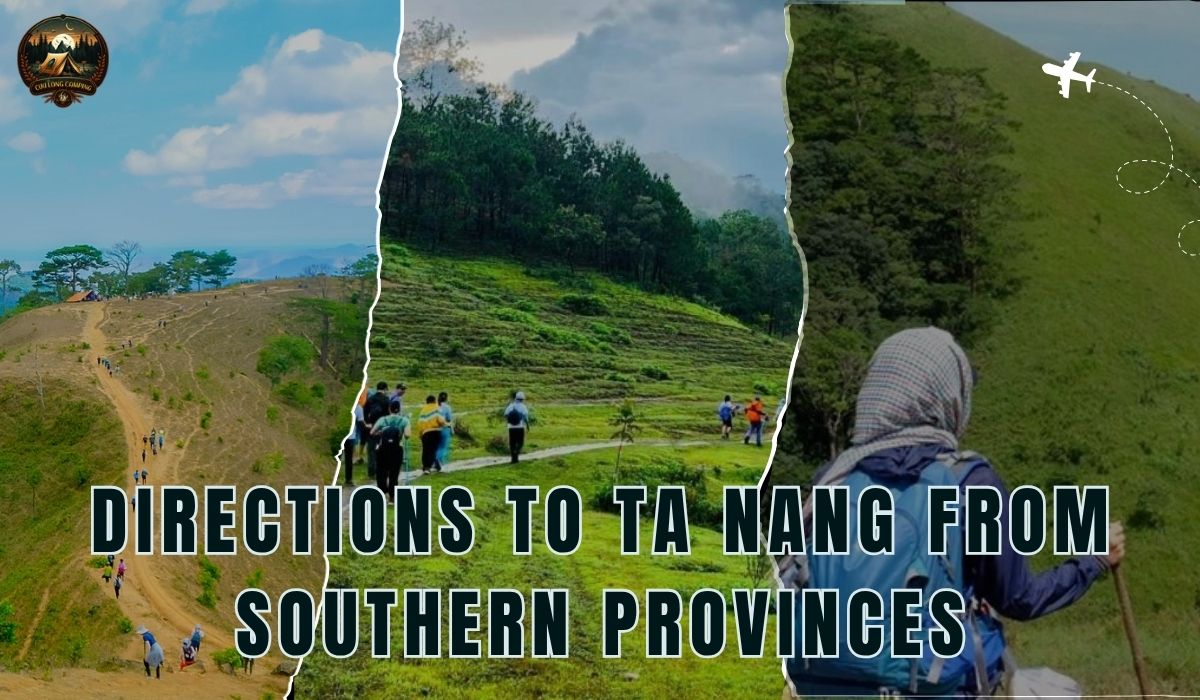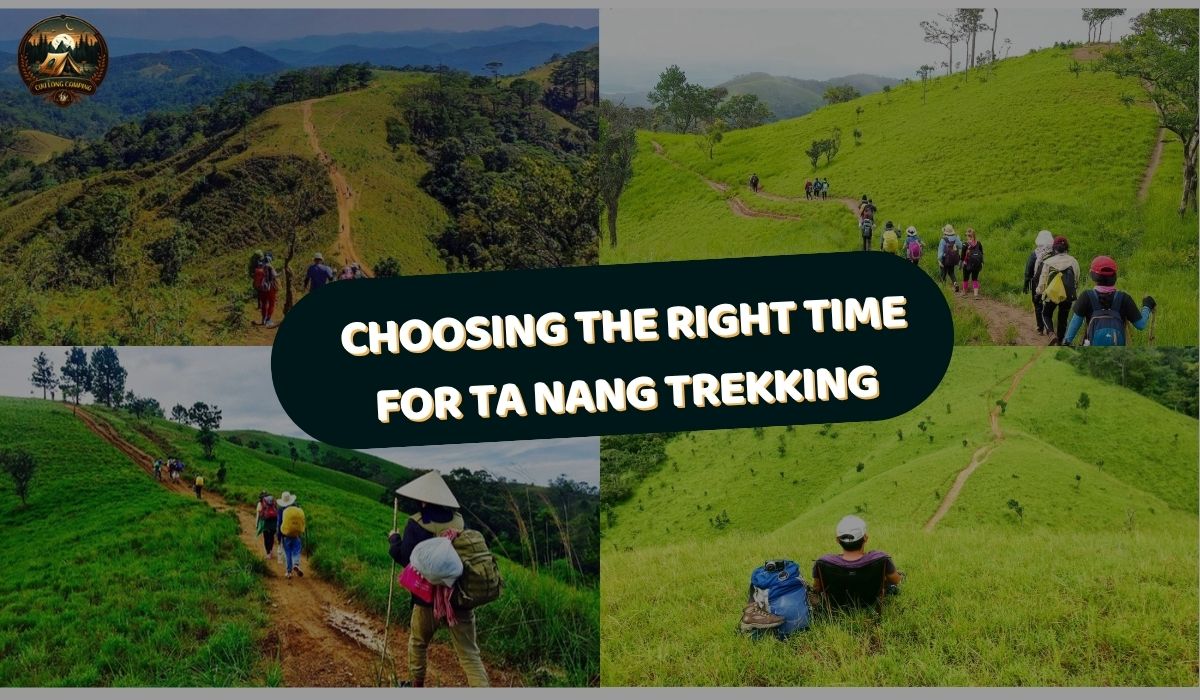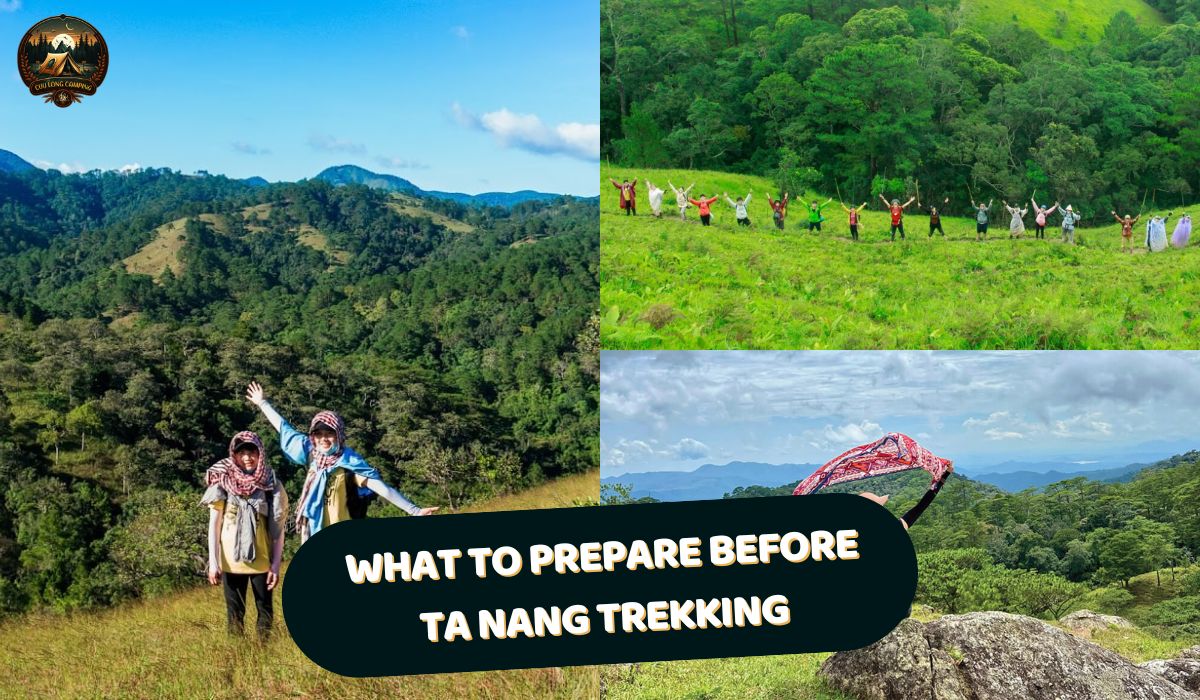Ta Nang – Phan Dung, a beautiful trekking route connecting the three provinces of Lam Dong, Ninh Thuan, and Binh Thuan, has long been an attractive destination for those who love exploring and conquering nature. With majestic natural landscapes, endless rolling green hills, murmuring streams, and vast pine forests, Ta Nang promises unforgettable experiences. However, to have a safe and complete Ta Nang trekking trip, thorough preparation is extremely important. This article by Cuu Long Camping will share detailed Ta Nang trekking experiences from A to Z, helping you confidently conquer this route.
Directions to Ta Nang from Southern Provinces

To reach Ta Nang, the starting point for the Ta Nang – Phan Dung trekking journey, you need to travel to Ta Nang commune, Duc Trong district, Lam Dong province.
See more: Trekking Ta Lien Mountain: Conquering the “Fairy Forest” in the Heart of Northwest Vietnam.
Here are detailed directions from Southern provinces:
1. From Ho Chi Minh City:
- Coach: This is the most popular and convenient mode of transportation. You can buy coach tickets to Da Lat at Mien Dong Bus Station. Reputable bus companies like Thanh Buoi, Phuong Trang, and Mai Linh all have this route. After arriving in Da Lat, take a bus or taxi to Duc Trong (about 30-40km) and continue to Ta Nang commune.
- Self-driving car/motorbike:
- Route 1 (National Highway 20): Follow National Highway 20 through Dong Nai, Lam Dong to Duc Trong. From Duc Trong, head towards Ta Nang. This route is about 300km and takes about 6-8 hours.
- Route 2 (Long Thanh – Dau Giay Expressway): Take the Long Thanh – Dau Giay Expressway to Dau Giay, then turn onto National Highway 20 to Da Lat. Upon reaching Duc Trong, continue to Ta Nang commune. This route saves more time compared to traveling entirely on National Highway 20.
2. From Southeastern Provinces (Dong Nai, Binh Duong, Ba Ria – Vung Tau):
You can travel to Ho Chi Minh City and then follow the instructions above. Alternatively, depending on your specific location, you can find coach routes that go directly to Duc Trong or Da Lat.
3. From Southwestern Provinces (Can Tho, An Giang, Kien Giang, etc.):
You can travel by coach to Ho Chi Minh City and then continue to Da Lat/Duc Trong as instructed in section 1. Some coach routes may go directly from Southwestern provinces to Da Lat, but the number of trips might be more limited.
4. To Ta Nang Commune from Duc Trong:
From Duc Trong district center, you can take a motorbike taxi (xe om), taxi, or rent a motorbike to get to Ta Nang commune. The road is quite easy to find; you can ask local people for specific directions.
Choosing the Right Time for Ta Nang Trekking

Choosing the right time for Ta Nang trekking is very important as it directly affects your experience and safety. The weather in Ta Nang has two distinct seasons: the rainy season and the dry season, each bringing its own beauty but also its own difficulties.
1. Dry Season (approximately December to May):
- Advantages:
- Weather: Dry, little rain, favorable for moving and camping.
- Trail: Dry, easier to walk, less slippery.
- Scenery: The grass turns yellow, creating a pristine, romantic, and poetic landscape. This is also an ideal time for photography.
- Disadvantages:
- Weather: Can be quite hot during the day, especially in the peak months of the dry season (March, April, May). You need to prepare enough water and sunscreen.
- Dry grass: Flammable, be careful when using campfires.
2. Rainy Season (approximately June to November):
- Advantages:
- Scenery: Lush green grass stretching across the hills, creating a vibrant and lively landscape.
- Weather: Cooler than the dry season.
- Disadvantages:
- Weather: Frequent rain, slippery trails, difficult to move, prone to mud.
- Insects and leeches: More abundant than in the dry season.
- Danger: Higher risk of flash floods and landslides.
So when should you go to Ta Nang?
- If you prefer yellow grass scenery and dry, easy-to-move weather: Go during the dry season (December to May). However, be prepared for hot weather and remember to bring enough water.
- If you prefer lush green grass scenery and don’t mind difficulties: Go during the rainy season (June to November). However, you need to prepare carefully with appropriate clothing, non-slip footwear, and monitor the weather forecast closely.
What to Prepare Before Ta Nang Trekking

To have a safe and complete Ta Nang trekking trip, thorough preparation is extremely important. Here is a list of things you need to prepare before heading out:
1. Health and Physical Fitness:
- Physical training: Ta Nang trekking requires endurance and good stamina. Exercise regularly for at least 1-2 months before the trip, focusing on cardio exercises (running, swimming, cycling) and leg strengthening exercises (squats, stair climbing).
- Health check-up: If you have any health issues, consult a doctor before participating in trekking.
- Adequate nutrition: Ensure a nutritious diet to maintain optimal health.
2. Research Information:
- Learn about the route: Thoroughly research the terrain, length, and difficulty of the Ta Nang – Phan Dung route.
- Learn about the weather: Monitor the weather forecast before the trip to prepare appropriate clothing and gear.
- Learn about attractions: Find out about rest stops, camping spots, and attractions along the route.
3. Prepare Your Gear:
- Trekking shoes: Choose shoes with good grip, waterproof, snug-fitting, and already broken-in.
- Trekking backpack: Choose a backpack of appropriate size for the number of days, with load-bearing straps and comfortable to wear.
- Clothing:
- Comfortable, sweat-wicking, and quick-drying clothes (preferably polyester or nylon).
- Windbreaker or waterproof jacket.
- Warm jacket (if going during the cold season or in the evening).
- Underwear.
- Socks (bring enough for each day).
- Personal items:
- Sunscreen.
- Hat, cap.
- Sunglasses.
- Insect repellent.
- Flashlight (headlamp is best).
- Toothbrush, toothpaste, face towel.
- Toilet paper, wet wipes.
- Personal medication (stomachache medicine, cold medicine, antiseptic, band-aids…).
- Personal trash bag.
- Camping gear (if camping):
- Tent.
- Sleeping bag.
- Insulating pad.
- Tent light.
- Food and drinks:
- Drinking water (sufficient for the entire journey, you can bring water purification tablets or water disinfectant).
- Snacks (bread, dried food, fruit, chips, chocolate…).
- Main meals (if cooking your own).
- Stove and cooking utensils (if cooking your own).
- Other items:
- Map, compass, or GPS.
- Trekking poles (help reduce pressure on knees).
- Multi-tool knife.
- Lighter or matches (stored in a waterproof bag).
- Zip-lock bags for organizing.
- Power bank.
- Camera, phone.
4. Detailed Planning:
- Choose an itinerary: Determine the number of days for the trip, starting point, ending point, and rest stops.
- Find out about porters or guides: If you are inexperienced, you should hire a porter or guide to ensure safety.
- Book services (if any): Book transportation, accommodation (if any), and other services.
- Make a list of group members and contact information: For easy communication when needed.
- Inform relatives about the itinerary: To ensure safety.
5. Mental Preparation:
- Learn about local culture and customs: To avoid inappropriate actions.
- Prepare mentally for difficulties and challenges: Ta Nang trekking may encounter difficulties such as bad weather, rugged terrain, insects… Be prepared to face and overcome them.
- Maintain a relaxed and cheerful spirit: To fully enjoy the trip.
We are a group of young people in the Mekong Delta who are passionate about travel, with the dream of discovering many beautiful places to develop sustainable and environmentally friendly tourism. Follow Cuu Long Camping to explore all the beautiful scenery of the Mekong Delta and many new lands on our trips here!





